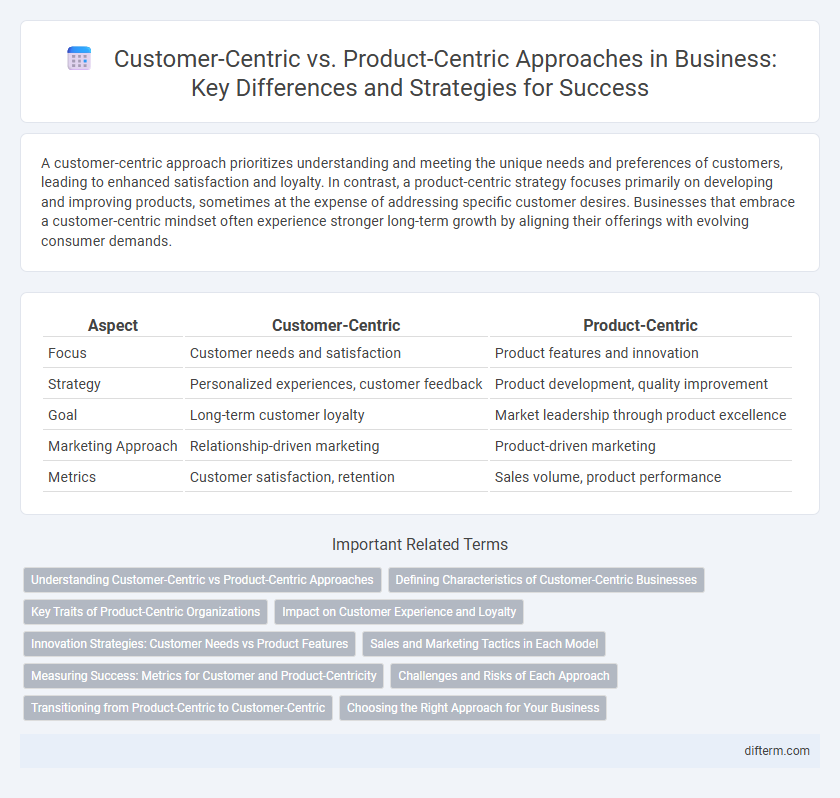A customer-centric approach prioritizes understanding and meeting the unique needs and preferences of customers, leading to enhanced satisfaction and loyalty. In contrast, a product-centric strategy focuses primarily on developing and improving products, sometimes at the expense of addressing specific customer desires. Businesses that embrace a customer-centric mindset often experience stronger long-term growth by aligning their offerings with evolving consumer demands.
Table of Comparison
| Aspect | Customer-Centric | Product-Centric |
|---|---|---|
| Focus | Customer needs and satisfaction | Product features and innovation |
| Strategy | Personalized experiences, customer feedback | Product development, quality improvement |
| Goal | Long-term customer loyalty | Market leadership through product excellence |
| Marketing Approach | Relationship-driven marketing | Product-driven marketing |
| Metrics | Customer satisfaction, retention | Sales volume, product performance |
Understanding Customer-Centric vs Product-Centric Approaches
Customer-centric approaches prioritize understanding and meeting customer needs, driving business strategies based on customer feedback and behavior data. Product-centric models focus on innovating and optimizing the product itself, emphasizing features and performance to capture market share. Companies adopting a customer-centric mindset leverage insights from customer journeys and satisfaction metrics to enhance loyalty and long-term growth.
Defining Characteristics of Customer-Centric Businesses
Customer-centric businesses prioritize understanding and addressing customer needs, preferences, and feedback to enhance satisfaction and loyalty. These organizations integrate personalized experiences, proactive support, and continuous engagement into their operations, using data analytics to tailor offerings effectively. Emphasizing long-term relationships over immediate sales drives sustained growth and competitive advantage.
Key Traits of Product-Centric Organizations
Product-centric organizations prioritize product innovation, quality, and features to drive market success, often emphasizing technical excellence and scalability. Their key traits include a strong focus on research and development, continuous improvement of product offerings, and investment in cutting-edge technologies. These companies typically measure success through product performance metrics, market share growth, and customer adoption rates rather than individual customer needs or experience.
Impact on Customer Experience and Loyalty
Customer-centric strategies prioritize understanding and addressing individual customer needs, significantly enhancing customer experience and fostering long-term loyalty through personalized interactions. In contrast, product-centric approaches concentrate on product features and innovation, which may improve functionality but often overlook the evolving preferences and emotions driving customer satisfaction. Businesses adopting a customer-centric mindset typically achieve higher retention rates and advocacy, directly influencing growth and competitive advantage.
Innovation Strategies: Customer Needs vs Product Features
Customer-centric innovation strategies prioritize understanding and addressing customer needs, leveraging data analytics and feedback to tailor solutions that enhance user experience and satisfaction. In contrast, product-centric approaches emphasize developing advanced features and technological advancements, often guided by internal R&D capabilities and market trends. Balancing these strategies enables businesses to deliver innovative products that resonate with target audiences while maintaining competitive differentiation.
Sales and Marketing Tactics in Each Model
Sales and marketing tactics in customer-centric models prioritize personalized communication, leveraging customer data analytics to tailor campaigns and enhance engagement. Product-centric strategies emphasize highlighting product features and benefits through mass advertising and standardized messaging to maximize reach and product appeal. Integrating customer feedback in customer-centric approaches drives adaptive marketing efforts, while product-centric tactics rely on product innovation to attract target markets.
Measuring Success: Metrics for Customer and Product-Centricity
Measuring success in customer-centric models prioritizes metrics like Net Promoter Score (NPS), customer lifetime value (CLV), and customer satisfaction (CSAT), emphasizing long-term loyalty and experience. Product-centric approaches focus on product performance indicators such as feature adoption rates, release cycle velocity, and defect density to optimize development efficiency and market fit. Aligning key performance indicators (KPIs) with business strategy ensures balanced growth by integrating customer feedback with product innovation data.
Challenges and Risks of Each Approach
Customer-centric strategies face challenges such as accurately capturing diverse customer needs and adapting to rapidly changing preferences, which can lead to increased operational complexity and higher costs. Product-centric approaches risk misalignment with market demands, resulting in overinvestment in features that customers may find irrelevant or outdated, potentially causing reduced market share. Both approaches require balancing resource allocation carefully to avoid strategic blind spots that could hinder business growth and competitiveness.
Transitioning from Product-Centric to Customer-Centric
Shifting from a product-centric to a customer-centric approach requires businesses to realign strategies toward customer needs, preferences, and experiences rather than solely focusing on product features and innovations. Employing customer data analytics and feedback loops enables personalized offerings and improves customer satisfaction, retention, and lifetime value. This transition demands organizational culture changes, cross-functional collaboration, and investment in customer relationship management (CRM) tools to drive business growth and competitive advantage.
Choosing the Right Approach for Your Business
Customer-centric strategies prioritize understanding and meeting consumer needs, driving higher satisfaction and loyalty, which often leads to sustained revenue growth. Product-centric approaches emphasize innovation and feature development, targeting market differentiation through superior product offerings. Selecting the appropriate focus depends on factors such as market dynamics, competitive landscape, and long-term business goals to maximize value creation.
customer-centric vs product-centric Infographic

 difterm.com
difterm.com